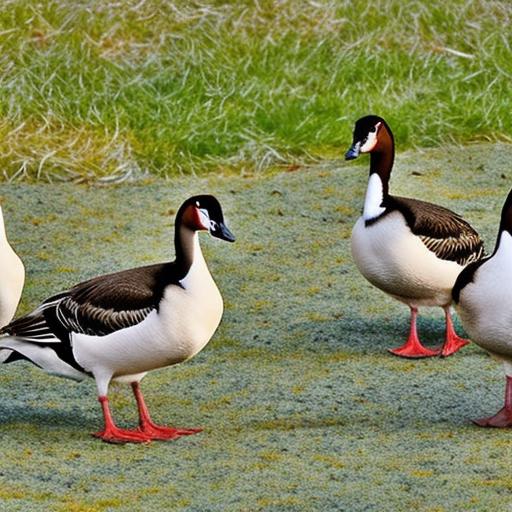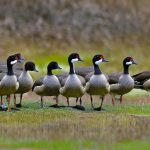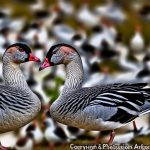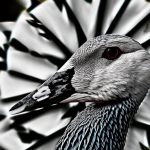Canadian geese invading yards can be a common problem for homeowners, especially those who live near bodies of water. These large birds can cause damage to landscaping, leave behind droppings that can be unsightly and unsanitary, and even pose health risks. Understanding their behavior and the reasons why they invade yards is crucial in order to effectively prevent them from causing damage. In this article, we will explore the behavior of Canadian geese, the reasons why they invade yards, the impact they can have on your yard, and provide tips for preventing and dealing with their presence.
Key Takeaways
- Canadian geese are social birds that mate for life and are highly protective of their young.
- Geese may invade your yard for food, water, shelter, or nesting sites.
- Geese can cause damage to your yard by eating grass, leaving droppings, and creating nests.
- Prevent geese from entering your yard by removing food sources, using physical barriers, and using natural deterrents.
- Physical barriers such as fences, netting, and decoys can effectively keep geese out of your yard.
Understanding Canadian Geese Behavior
Canadian geese are known for their distinctive honking sound and their V-shaped flying formations during migration. They are migratory birds that travel long distances between their breeding grounds in the north and their wintering grounds in the south. During migration, they often stop at bodies of water to rest and feed. In the spring, they return to their breeding grounds to mate and raise their young.
When it comes to nesting, Canadian geese prefer areas near water that provide both food and protection. They typically build their nests on the ground near bodies of water, such as ponds or lakes. They are known to be territorial during nesting season and will defend their nests aggressively if they feel threatened.
Reasons Why Canadian Geese Invade Your Yard
There are several reasons why Canadian geese may choose to invade your yard. One common reason is the availability of food. Canadian geese are herbivores and feed on grasses, grains, and aquatic plants. If your yard has an abundance of these food sources, it may attract geese looking for a meal.
Another reason is the availability of nesting sites. Canadian geese prefer areas near water where they can build their nests and raise their young. If your yard has suitable nesting sites, such as open grassy areas near ponds or lakes, it may be attractive to geese looking for a safe place to nest.
The Impact of Canadian Geese on Your Yard
The presence of Canadian geese in your yard can have a negative impact on your landscaping and overall yard aesthetics. Geese are known to graze on grass, which can result in patches of bare soil and damaged turf. Their droppings can also be a nuisance, as they are unsightly and can create an unpleasant odor. In addition, goose droppings can contain bacteria that can pose health risks to humans and pets.
Furthermore, geese can be aggressive and territorial, especially during nesting season. They may hiss, flap their wings, or even charge at humans or other animals that they perceive as a threat. This can be intimidating and potentially dangerous, especially for children or small pets.
Tips for Preventing Canadian Geese from Entering Your Yard
Preventing Canadian geese from entering your yard requires a combination of strategies. Here are some practical tips to help keep geese away:
1. Remove food sources: Make sure there are no food sources available for geese in your yard. This includes removing fallen fruits or berries, cleaning up spilled birdseed, and not feeding waterfowl.
2. Keep your yard clean: Regularly clean up any debris or clutter in your yard that may attract geese. This includes removing fallen leaves, trimming overgrown vegetation, and keeping your lawn well-maintained.
3. Use noise deterrents: Geese are sensitive to loud noises and may be deterred by the sound of barking dogs, clapping hands, or using noise-making devices such as air horns or whistles.
4. Install motion-activated sprinklers: Motion-activated sprinklers can startle geese and discourage them from entering your yard. These sprinklers are triggered by movement and can be an effective deterrent.
5. Use visual deterrents: Geese are wary of unfamiliar objects, so placing decoys or other visual deterrents in your yard can help keep them away. These can include fake predators, such as plastic owls or coyotes, or reflective objects like shiny tape or balloons.
Physical Barriers to Keep Canadian Geese Out
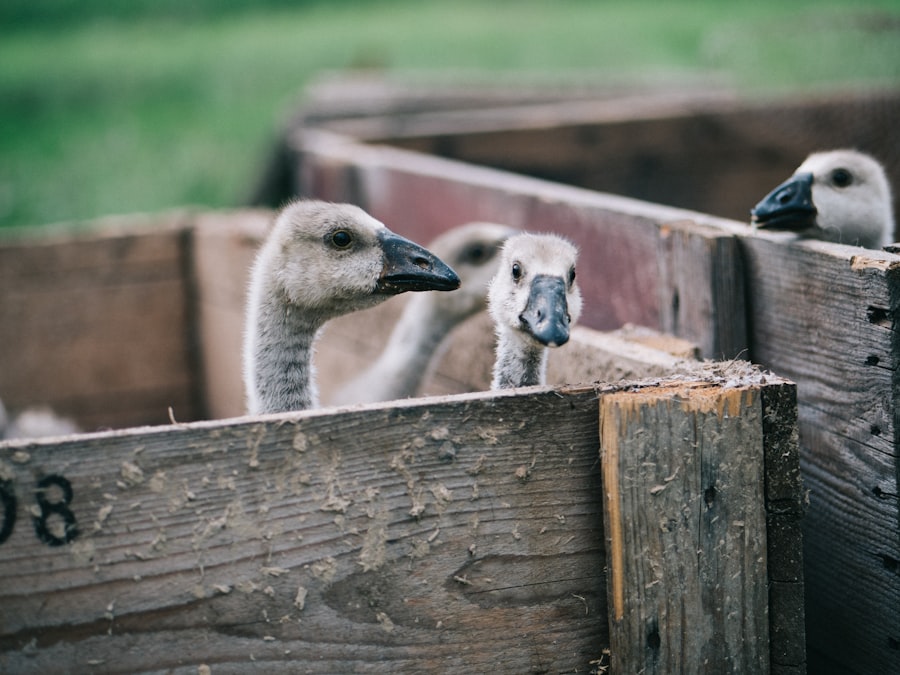
Physical barriers can be an effective way to keep Canadian geese out of your yard. Fencing is one option, but it needs to be at least three feet high and have small enough gaps to prevent geese from squeezing through. Netting can also be used to cover areas where geese may try to land or nest, such as ponds or rooftops.
While physical barriers can be effective, they may not be practical for all yards. Fencing can be expensive and may not be aesthetically pleasing. Netting may also require regular maintenance to ensure it remains effective.
Natural Deterrents for Canadian Geese
There are several natural deterrents that can help keep Canadian geese away from your yard. Planting certain types of vegetation can make your yard less attractive to geese. They prefer open grassy areas, so planting tall grasses or shrubs can create a less appealing habitat for them.
Using decoys can also be an effective natural deterrent. Placing decoys of predators, such as plastic coyotes or owls, in your yard can make geese think twice about landing or nesting there.
It’s important to note that natural deterrents may not work for all situations and may require regular maintenance to remain effective.
The Importance of Consistency in Keeping Geese Away
Consistency is key when it comes to preventing Canadian geese from invading your yard. It’s important to implement prevention methods and deterrents consistently in order to effectively keep geese away. Inconsistent efforts can actually attract geese to your yard, as they may become accustomed to intermittent disturbances or find new food sources when old ones are removed.
What to Do if Canadian Geese Have Already Invaded Your Yard
If Canadian geese have already invaded your yard, there are several steps you can take to deal with the situation. Using noise deterrents, such as clapping hands or using noise-making devices, can help scare geese away. Removing nesting materials, such as twigs or grass, can also discourage geese from staying in your yard.
It’s important to approach the situation in a humane manner and avoid causing harm to the geese. Harassing or injuring geese is not only cruel, but it may also be illegal under wildlife protection laws.
The Role of Professional Services in Keeping Canadian Geese Away
In some cases, it may be necessary to seek professional services to prevent and remove Canadian geese from your yard. Professional wildlife control services have the knowledge and experience to effectively deal with geese infestations. They can provide expert advice on prevention methods, install physical barriers, and safely remove geese from your property.
Using professional services can save you time and effort, and ensure that the problem is dealt with effectively and humanely.
Maintaining a Goose-Free Yard in the Long Term
Once you have successfully prevented or removed Canadian geese from your yard, it’s important to maintain a goose-free environment in the long term. Regular maintenance of your yard, such as removing fallen leaves and trimming overgrown vegetation, can help make your yard less attractive to geese.
Monitoring your yard for signs of geese or potential attractants is also important. If you notice any signs of geese returning or new food sources appearing, take immediate action to address the issue before it becomes a larger problem.
Canadian geese invading yards can be a nuisance and cause damage to landscaping. Understanding their behavior and implementing effective prevention methods is crucial in order to keep your yard goose-free. By removing food sources, keeping your yard clean, using noise and visual deterrents, and considering physical barriers or professional services, you can successfully prevent and remove Canadian geese from your yard. Taking action to keep geese away will not only protect your property, but also ensure the health and safety of your family and pets.
If you’re tired of dealing with Canadian geese invading your yard, you may be interested in learning more about effective strategies to keep them at bay. One helpful resource is an article on Poultry Wizard titled “How to Keep Canadian Geese Out of Your Yard.” This informative piece provides valuable insights and practical tips on deterring these persistent birds from taking over your property. From understanding their behavior to implementing deterrents, this article offers a comprehensive guide to reclaiming your yard. Check it out here for expert advice on protecting your space from unwanted geese.
FAQs
What are Canadian geese?
Canadian geese are a species of waterfowl that are native to North America. They are known for their distinctive black heads and necks, white cheeks, and brown bodies.
Why do Canadian geese come into my yard?
Canadian geese are attracted to yards that have open spaces, water sources, and plenty of grass to graze on. They may also be attracted to yards that have bird feeders or other sources of food.
Are Canadian geese dangerous?
Canadian geese are generally not dangerous to humans, but they can become aggressive if they feel threatened or if they are protecting their young. They may also carry diseases that can be transmitted to humans.
How can I keep Canadian geese out of my yard?
There are several ways to keep Canadian geese out of your yard, including using physical barriers like fences or netting, using noise deterrents like sirens or loud music, and using visual deterrents like scarecrows or reflective tape.
Is it legal to harm or kill Canadian geese?
No, it is illegal to harm or kill Canadian geese without a permit from the government. Canadian geese are protected under the Migratory Bird Treaty Act, which prohibits the hunting, killing, or possession of migratory birds without a permit.
Meet Walter, the feathered-friend fanatic of Florida! Nestled in the sunshine state, Walter struts through life with his feathered companions, clucking his way to happiness. With a coop that’s fancier than a five-star hotel, he’s the Don Juan of the chicken world. When he’s not teaching his hens to do the cha-cha, you’ll find him in a heated debate with his prized rooster, Sir Clucks-a-Lot. Walter’s poultry passion is no yolk; he’s the sunny-side-up guy you never knew you needed in your flock of friends!

